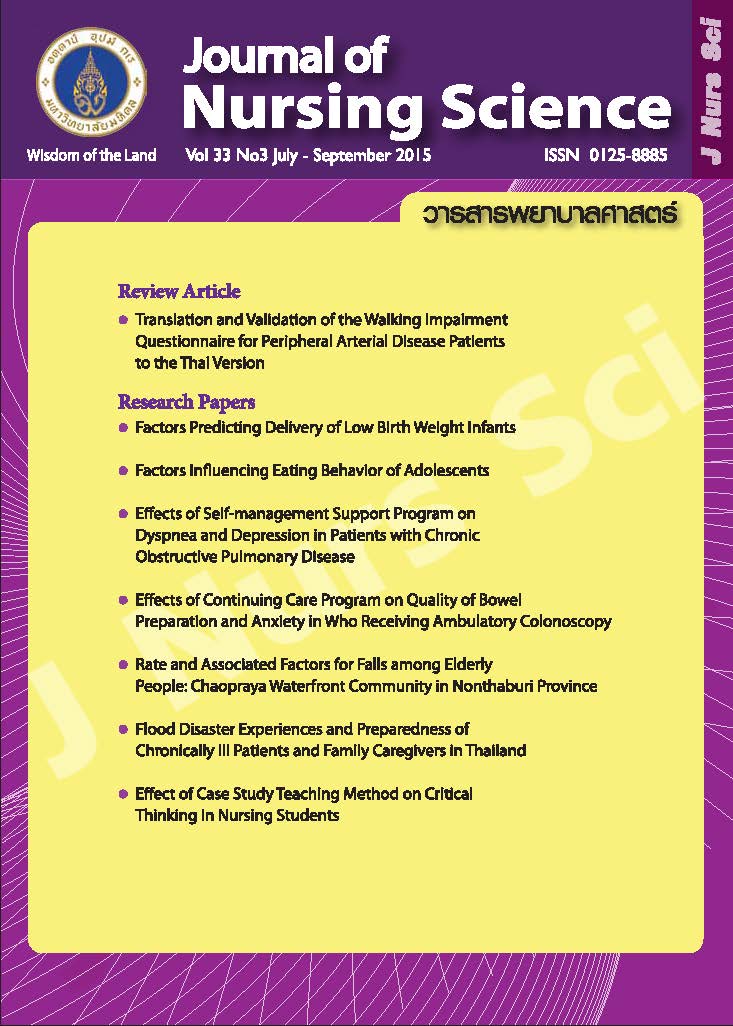Dyspnea and Depression in Patients with Chronic Obstructive Pulmonary Disease
Main Article Content
Abstract
Purpose: This studied aimed to examine effects of a self-management support program on dyspnea and depression in patients with chronic obstructive pulmonary disease (COPD).
Design: A quasi experimental design.
Methods: Seventy patients with chronic obstructive pulmonary disease were divided into the experimental and control group with 35 each who had been admitted at a secondary hospital with dyspnea. The experimental group received a self-management support program which comprised self-management education and skills training using a patient-centered approach, family support, home visit and follow up activities. The program was carried out for 8 weeks and evaluated for outcomes at week 4 and week 8. Data were collected through personal data questionnaire, the dyspnea visual analogue scale, and Center for Epidemiologic Studies-Depression Scale (CES-D) questionnaire. Data were analyzed using descriptive statistics, T-test, and Repeated measures ANOVA with between subjects factors.
Main findings: Almost all (99.3 percent) of the sample were men and mean age was 68.64 years (SD = 8.99). Experimental and control groups showed no differences in age. Experimental and control groups had no significant difference in dyspnea (F = 3.454, df = 1, p = .067). Mean score of dyspnea in experimental group was significantly decreased when compare with control group only in week 8 (p < .05). Experimental and control groups had significant difference in depression (F = 7.858, df = 1, p = .007). Mean score of depression in experimental group was significantly decreased when compared with control group both in weak 4 and week 8 (p < .05).
Conclusion and recommendations: The study findings suggest that the success of a self-management support program for COPD patients depend on patient involvement in self-management planning with supported by family along with effective nurse-patient partnership in patients care.
ผลของการใช้โปรแกรมสนับสนุนการจัดการตนเองต่ออาการหายใจลำบาก และภาวะซึมเศร้าในผู้ป่วยโรคปอดอุดกั้นเรื้อรัง
บทคัดย่อ
วัตถุประสงค์: เพื่อศึกษาผลของการใช้โปรแกรมสนับสนุนการจัดการตนเองต่ออาการหายใจลำบากและภาวะซึมเศร้าในผู้ป่วยโรคปอดอุดกั้นเรื้อรัง
รูปแบบการวิจัย: การวิจัยกึ่งทดลอง
วิธีดำเนินการวิจัย: กลุ่มตัวอย่างเป็นผู้ป่วยปอดอุดกั้นเรื้อรัง เข้ารับการรักษาในหอผู้ป่วยอายุกรรมโรงพยาบาลระดับทุติยภูมิแห่งหนึ่ง ด้วยอาการหายใจลำบากจำนวน 70 ราย แบ่งเป็นกลุ่มควบคุม 35 ราย กลุ่มทดลอง 35 ราย กลุ่มควบคุมได้รับการพยาบาลตามปกติ กลุ่มทดลองได้รับโปรแกรมสนับสนุนการจัดการตนเอง ซึ่งประกอบด้วยการให้ความรู้และฝึกทักษะพื้นฐานในการจัดการตนเอง และการสนับสนุนให้ผู้ป่วยปฏิบัติกิจกรรมการจัดการตนเองโดยยึดผู้ป่วยเป็นศูนย์กลางร่วมกับการสนับสนุนให้ครอบครัวมีส่วนร่วมและติดตามเยี่ยมประเมินผลในสัปดาห์ที่ 4 และ 8 หลังจำหน่าย เครื่องมือที่ใช้ในการวิจัยประกอบด้วย แบบบันทึกข้อมูลส่วนบุคคล แบบประเมินอาการหายใจลำบาก และแบบประเมินภาวะซึมเศร้า วิเคราะห์ข้อมูลโดยใช้สถิติเชิงบรรยาย การทดสอบที และ Repeated measures ANOVA with between subjects factors
ผลการวิจัย: กลุ่มตัวอย่างเกือบทั้งหมด (ร้อยละ 99.3) เป็นผู้ชาย อายุเฉลี่ย 68.64 (SD = 8.99) กลุ่มทดลองและกลุ่มควบคุมมีอายุไม่แตกต่างกัน ภายหลังการทดลองกลุ่มทดลองมีอาการหายใจลำบากแตกต่างจากกลุ่มควบคุมอย่างไม่มีนัยสำคัญทางสถิติ (F = 3.454, df = 1, p = .067) โดยคะแนนเฉลี่ยอาการหายใจลำบากในกลุ่มทดลองลดลงแตกต่างจากกลุ่มควบคุมอย่างมีนัยสำคัญทางสถิติ (p < .05) เฉพาะหลังการทดลองสัปดาห์ที่ 8 คะแนนภาวะซึมเศร้าระหว่างกลุ่มทดลองและกลุ่มควบคุมภายหลังการทดลองมีความแตกต่างกันอย่างมีนัยสำคัญทางสถิติ (F = 7.858, df = 1, p = .007) โดยคะแนนเฉลี่ยภาวะซึมเศร้าของกลุ่มทดลองเมื่อครบ 4 สัปดาห์ และ 8 สัปดาห์ลดลงมากกว่ากลุ่มควบคุมอย่างมีนัยสำคัญทางสถิติ (p < .05)
สรุปและข้อเสนอแนะ: โปรแกรมการจัดการตนเองในผู้ป่วยปอดอุดกั้นเรื้อรังจะประสบผลสำเร็จได้ผู้ป่วยจะต้องมีส่วนร่วมในการวางแผนจัดกิจกรรม และครอบครัวเป็นผู้สนับสนุน โดยพยาบาลทำหน้าที่เป็นหุ้นส่วนในการดูแลตนเองของผู้ป่วย
คำสำคัญ: ปอดอุดกั้นเรื้อรัง โปรแกรมสนับสนุนการจัดการตนเอง อาการหายใจลำบาก ภาวะซึมเศร้า
Article Details
Copyright Notice: Nursing Science Journal of Thailand has exclusive rights to publish and distribute the manuscript and all contents therein. Without the journal’s permission, the dissemination of the manuscript in another journal or online, and the reproduction of the manuscript for non-educational purpose are prohibited.

Disclaimer: The opinion expressed and figures provided in this journal, NSJT, are the sole responsibility of the authors. The editorial board bears no responsibility in this regard.


